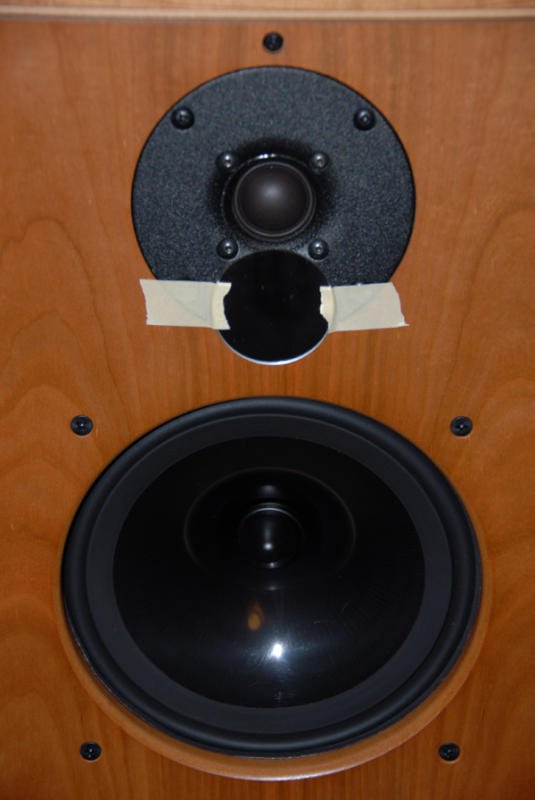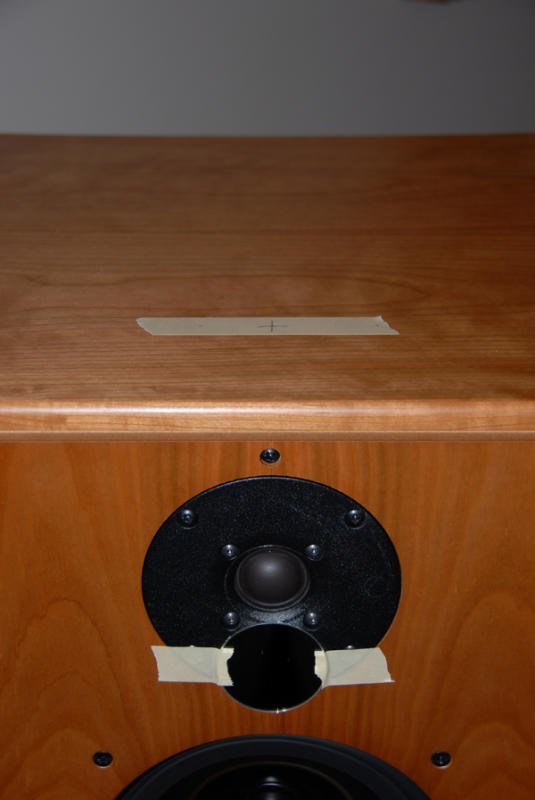I've mentioned using a small flat mirror to determine the first reflection points of your speakers on your listening room surfaces as viewed from your listening chair. The mirror I usually use is a 4" x 6" rectangular piece of flat silvered glass backed by cardboard and is about 1/8" thick. This mirror, with a couple of masking or blue painter's tape strips to hold it flat against the wall temporarily are just about perfect for this task. Such mirrors are relatively easy to find. One example is here.
For adjusting speaker toe in, ideally you want something a bit smaller. A 4" x 6" mirror will work with speakers like the Harbeth Monitor 40 or 40.1 because it will fit against the flat baffle between the midrange and the tweeter. However, for most speakers, you will need a smaller mirror in order to get it to fit flat against the speaker baffle near tweeter height. Also, a smaller mirror works more precisely for determining when speakers are toed in directly at my ears
I find that a 2-inch-diameter circular mirror is ideal for adjusting speaker toe-in. The smaller the mirror (at least up to some point), the more accurately you can judge that the toe-in is toward your ears since with a small mirror you really have to have the speaker aimed just about right before you see your ear's reflection. With larger mirrors, you have to judge whether the image of your ear is centered in the mirror.
Here are a couple of pictures of such a mirror mounted on the face of a Harbeth M40. The second one also shows the crosshair I attach to the top of speaker to measure the distance of the center of the woofer dust cap from nearby walls, regardless of the amount of toe-in used:


When adjusting speaker toe-in to aim the speakers at my ears, I sit in my listening chair and aim my head straight by listening to a monophonic recording. Listening for a centered image will automatically orient my head into the sweet spot facing straight ahead. The I glance to the side without moving my head to see if my left ear is reflected in the mirror attached to the left speaker looking only with my left eye (I cover up or close my right eye). I glance right without moving my head to see if my right ear is reflected in the mirror attached to the right speaker looking only with my right eye (I cover up or close my left eye). When everything is just right, you should see your ear canals reflected in the centers of the mirrors.
Such small, flat, light-weight mirrors are not so easy to find. The kind I bought no longer seems to be available. After some looking, however, I did locate at least one current wholesale source of such mirrors, Darice, and the two-inch mirrors from Darice are available to the retail market at Amazon here. Darice also makes similar thin circular mirrors in larger and smaller sizes.
By the way, for the wall reflections, I remember seeing a picture showing Robert Harley's technique for finding first reflection points. I think it was in one of "Guide to . . ." books. He applied a long continuous strip of silvered mylar at least a food wide to his room walls at about seated eye height and looked for the reflection points. Yes, that will work, too, but the points will be harder to mark on the wall for later treatment with sound absorbing material with all that mylar in the way.
For adjusting speaker toe in, ideally you want something a bit smaller. A 4" x 6" mirror will work with speakers like the Harbeth Monitor 40 or 40.1 because it will fit against the flat baffle between the midrange and the tweeter. However, for most speakers, you will need a smaller mirror in order to get it to fit flat against the speaker baffle near tweeter height. Also, a smaller mirror works more precisely for determining when speakers are toed in directly at my ears
I find that a 2-inch-diameter circular mirror is ideal for adjusting speaker toe-in. The smaller the mirror (at least up to some point), the more accurately you can judge that the toe-in is toward your ears since with a small mirror you really have to have the speaker aimed just about right before you see your ear's reflection. With larger mirrors, you have to judge whether the image of your ear is centered in the mirror.
Here are a couple of pictures of such a mirror mounted on the face of a Harbeth M40. The second one also shows the crosshair I attach to the top of speaker to measure the distance of the center of the woofer dust cap from nearby walls, regardless of the amount of toe-in used:


When adjusting speaker toe-in to aim the speakers at my ears, I sit in my listening chair and aim my head straight by listening to a monophonic recording. Listening for a centered image will automatically orient my head into the sweet spot facing straight ahead. The I glance to the side without moving my head to see if my left ear is reflected in the mirror attached to the left speaker looking only with my left eye (I cover up or close my right eye). I glance right without moving my head to see if my right ear is reflected in the mirror attached to the right speaker looking only with my right eye (I cover up or close my left eye). When everything is just right, you should see your ear canals reflected in the centers of the mirrors.
Such small, flat, light-weight mirrors are not so easy to find. The kind I bought no longer seems to be available. After some looking, however, I did locate at least one current wholesale source of such mirrors, Darice, and the two-inch mirrors from Darice are available to the retail market at Amazon here. Darice also makes similar thin circular mirrors in larger and smaller sizes.
By the way, for the wall reflections, I remember seeing a picture showing Robert Harley's technique for finding first reflection points. I think it was in one of "Guide to . . ." books. He applied a long continuous strip of silvered mylar at least a food wide to his room walls at about seated eye height and looked for the reflection points. Yes, that will work, too, but the points will be harder to mark on the wall for later treatment with sound absorbing material with all that mylar in the way.

